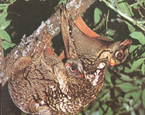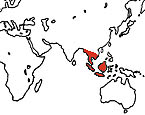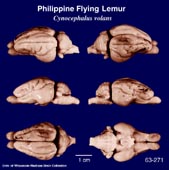|
Philippine
Flying Lemur
(Cynocephalus volans) #63-271 |
||||
|
|
Physical
characteristics and distribution
|
|
The
Philippine Flying Lemur is flat bodied with gliding membranes
from the neck to the hind feet. It has long limbs and
a tumbled tail. Head and body length ranges from 33-38cm
and total weight is 1-1.7 kg. The fur is brown with black
lines and white sections. The Philippine Flying Lemur
has sharp claws which allow it to hang from trees blending
in with the branches. It is strictly arboreal roosting in hollow trees or among palm fronds. It is an awkward climber but glides easily from tree to tree at lengths of up to 200 feet. It is mainly nocturnal and feeds on fruits, buds, flowers and leaves. It obtains water by licking on wet leaves. Several individuals may share the same shelter. A single offspring is born after a 60-day gestation period. Offspring are carried on the mother's abdomen protected by her gliding membrane. The Philippine Flying Lemur occurs on the Philippine Isls: Dinagat, Mindanao, Basilan, Samar, Siargao, Leyte, and Bohol. |
|
Description
of the brain
|
|
Animal
source and preparation
|
|
All
specimens collected followed the same preparation
and histological procedure.
|
Other Related Resources (websites and publications)
List of Specimens | Explore Collections | Brain Sections | Brain Evolution | Brain Development | Brain Circuitry | Brain Functions | Location and Use | Related Web Sites | Contact Us | Search MSU Database | Personnel | Home



